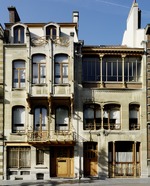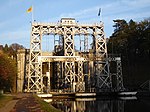This article lists the sites registered with World Heritage in Belgium.
Understand
The Belgium ratified the Convention for the Protection of the World Cultural and Natural Heritage on July 24, 1996.
The country has 13 properties (spread over 65 sites) inscribed on the World Heritage. Twelve are cultural and one is natural.
Belgium also submitted 17 sites to the tentative list: 15 cultural, 1 natural and 1 mixed.
Listing
| Site | Type | Criterion | Description | Drawing | |||||||||||||||||||||
|---|---|---|---|---|---|---|---|---|---|---|---|---|---|---|---|---|---|---|---|---|---|---|---|---|---|
| 1 Grand-Place in Brussels | Cultural | (ii), (iv) | The Grand-Place in Brussels is a remarkably homogeneous set of public and private buildings, dating mainly from the end of the XVIIe century, whose architecture vividly sums up and illustrates the social and cultural quality of this important political and commercial center. |  | |||||||||||||||||||||
| 2 Stoclet Palace | Cultural | (i), (ii) | The Palace was designed in 1905 at the request of banker and collector Adolphe Stoclet by one of the leaders of the art movement of the Vienna Secession, architect Josef Hoffman. The latter was able to work without financial or aesthetic limits. With their refined geometry, the palace and the garden (completed in 1911) mark a radical change within Art Nouveau, a change that heralds Art Deco and the modernist movement in architecture. The Stoclet Palace is one of the most successful achievements of the Vienna Secession. It houses works by Koloman Moser and Gustav Klimt, related to the design of the Gesamtkunstwerk (architecture, sculpture, painting and decorative arts are integrated in the same work). The Palace bears witness to the artistic renewal of European architecture and presents a high level of integrity in its dimensions of exterior architecture, interior architecture and decoration, with original furniture and objects. |  | |||||||||||||||||||||
| Major mining sites in Wallonia 3 Blegny-Mine 4 Wood of Cazier 5 Bois-du-Luc 6 Grand-Hornu | Cultural | (ii), (iv) | The four sites of this property extend over a strip of 170 km long and 3 to 15 km wide, which crosses Belgium from west to east. These are the best preserved sites of the coal mining operation which spanned from the beginning of the XIXe century to the second half of the XXe century. The property provides examples of utopian architecture from the beginnings of the European industrial era, as part of a highly integrated industrial and urban architectural ensemble, in particular the colliery and the workers' city of Grand-Hornu, designed by the architect Bruno Renard in the first half of the XIXe century. Bois-du-Luc has many buildings erected from 1838 to 1909 and a colliery which is one of the oldest in Europe since it dates back to the end of the XVIIe century. Although Wallonia has hundreds of coal mines, most have lost their infrastructure while the integrity of the four components of this site has remained high. |  | |||||||||||||||||||||
| Flemish beguinages Hoogstraten, Bind (Ivy), Mechelen (Mechelen), Turnhout, Sint-Truiden (Sint-Truiden), Tongeren (Tongeren), Dendermonde (Termonde), Gent (Ghent), Sint-Amandsberg / Gent (Mont-Saint-Amand-lez-Gand), Diest, Leuven (Leuven), Brugge (Bruges), Kortrijk (Kortrijk) | Cultural | (ii) (iii) (iv) | The Beguines, these women who devoted their lives to God without withdrawing from the world, founded in XIIIe century of beguinages, closed groups meeting their spiritual and material needs. The Flemish beguinages form architectural ensembles made up of houses, churches, outbuildings and green spaces organized according to a spatial conception of urban or rural origin and built in styles specific to the Flemish cultural region. They are an exceptional testimony to the Beguine tradition that developed in northwestern Europe during the Middle Ages. |  | |||||||||||||||||||||
| Belfries of Belgium and France Province of Hainaut
Namur Province
Province of Antwerp
Province of West Flanders
Province of East Flanders
Province of Flemish Brabant
Province of Limbourg
| Cultural | (ii) (iv) | Twenty-three belfries, located in northern France, and the belfry of Gembloux, Belgium, were registered as a group and as an extension of the 32 Belgian belfries registered in 1999 as the Belfries of Flanders and Wallonia . Built between the XIe and the XVIIe century, they illustrate Romanesque, Gothic, Renaissance and Baroque architectural styles. They are highly significant symbols of the conquest of civil liberties. At a time when most Italian, German and English towns focused on building town halls, in part of north-western Europe the emphasis was on building belfries. As opposed to the keep (symbol of the lords) and the bell tower (symbol of the Church), the belfry, the third tower of the urban landscape, represented the power of the aldermen. Over the centuries, it has become the symbol of the power and prosperity of the municipalities. Belgium has 32 belfries, 25 in Flanders and 7 in Wallonia. |  | |||||||||||||||||||||
| 7 Notre-Dame Cathedral of Tournai | Cultural | (ii) (iv) | Built in the first half of XIIe century, the cathedral of Tournai is characterized by a Romanesque nave of an exceptional width, by the great sculptural richness of its capitals and by a transept loaded with five towers heralding Gothic art. Rebuilt at XIIIe century, the choir is pure Gothic style. |  | |||||||||||||||||||||
| 8 Plantin-Moretus House-Workshops-Museum Complex | Cultural | (ii) (iii) (iv) (vi) | The Plantin-Moretus Museum is a Renaissance and Baroque printing and publishing house. Located in Antwerp - along with Paris and Venice, one of the three most important cities for the early days of printing in Europe - it is closely linked to the history of the invention and distribution of typography. Its name pays homage to the greatest printer-publisher of the second half of the XVIe century: Christophe Plantin (around 1520-1589). In addition to its exceptional architectural value, the monument contains an important collection of objects testifying to life and work in Europe's most prolific printing and publishing house at the end of the 20th century. XVIe century. The business remained in operation until 1867 and its building houses an extensive collection of old printing equipment, a large library, valuable archives and works of art, including a painting by Rubens. |  | |||||||||||||||||||||
| Major houses of the architect Victor Horta (Brussels) 9 Hotel Tassel 10 Solvay Hotel 11 Hotel van Eetvelde 12 Horta house and workshop | Cultural | (i) (ii) (iv) | The four major residences - the Tassel Hotel, the Solvay Hotel, the Van Eetvelde Hotel and the Horta House and Workshop - located in Brussels and designed by the architect Victor Horta, one of the initiators of Art Nouveau, are among the most remarkable innovative works of architecture of the end of the XIXe century. The stylistic revolution illustrated by these works is characterized by the open plan, the diffusion of light and the brilliant integration of the curved lines of the decoration into the structure of the building. |  | |||||||||||||||||||||
| 13 The historic center of Bruges | Cultural | (ii) (iv) (vi) | Bruges is an exceptional example of medieval housing which has well preserved its historic urban fabric as it has evolved over the centuries and where the original Gothic building is part of the city's identity. Bruges, one of Europe's commercial and cultural capitals, has forged cultural ties with different parts of the world. This city is associated with the School of Painting of the Flemish Primitives. |  | |||||||||||||||||||||
| The four lifts of the Canal du Center and their sites, La Louvière and Le Roeulx (Hainaut) 14 Elevator n ° 1 15 Elevator n ° 2 16 Elevator n ° 3 17 Elevator n ° 4 | Cultural | (iii) (iv) | The four hydraulic boat lifts, grouped together on a short segment of the historic Canal du Center, constitute industrial monuments of the highest quality. Together with the canal itself and its associated structures, they offer a remarkably well-preserved and complete example of a late-1800s industrial landscape. XIXe century. Of the eight hydraulic boat lifts built at this time and at the beginning of the XXe century, the four elevators of the Canal du Center are the only ones in the world remaining in their original state of operation. |  | |||||||||||||||||||||
| Le Corbusier's architectural work, an exceptional contribution to the Modern Movement 18 Guiette House | Cultural | (i) (ii) (vi) | Chosen from the work of Le Corbusier, the 17 sites that make up this transnational serial property, spread over seven countries, bear witness to the invention of a new architectural language breaking with the past. They were carried out over half a century, throughout what Le Corbusier called “patient research”. The Capitol Complex in Chandigarh (India), the National Museum of Western Fine Arts in Tokyo (Japan), the Maison du Docteur Curutchet in La Plata (Argentina) and the Housing Unit in Marseille (France) ) reflect the solutions that the Modern Movement sought to provide, during the XXe century, to the challenges of renewing architectural techniques, in order to meet the needs of society. These masterpieces of human genius also attest to the internationalization of architectural practice on a global scale. With the Guiette House built in 1927 in Antwerp, Belgium has 1 site. |  | |||||||||||||||||||||
| 19 Neolithic flint mines at Spiennes (Mons) | Cultural | (i) (iii) (iv) | The Neolithic flint mines at Spiennes, which cover more than 100 hectares, are the largest and oldest mining centers in Europe. They are also remarkable for the diversity of the technical solutions implemented for extraction and for their direct link with a stand from the same period. | .jpg/150px-Spiennes_-_Minières_néolithiques_de_silex_(1).jpg) | |||||||||||||||||||||
| Primary beech forests of the Carpathians and other parts of Europe 20 Integral forest reserves of the Sonian forest | Natural | (ix) | The site is a transnational extension of the primary beech forests of the Carpathians and ancient beech forests of Germany (Slovakia, Ukraine and Germany) which now spans twelve countries. Since the end of the last Ice Age, the beech forests of Europe have spread rapidly from a few isolated refuges in the Alps, Carpathians, Mediterranean and Pyrenees in a few thousand years, a process which still continues. today. The successful expansion of beech is due to its flexibility and tolerance to different climatic, geographic and physical conditions. These primary forests, numbering 78, are spread over 13 countries. In Belgium, three areas of integral forest reserve of the Soignes forest are listed as heritage |  | |||||||||||||||||||||
Criteria legend
| |||||||||||||||||||||||||
